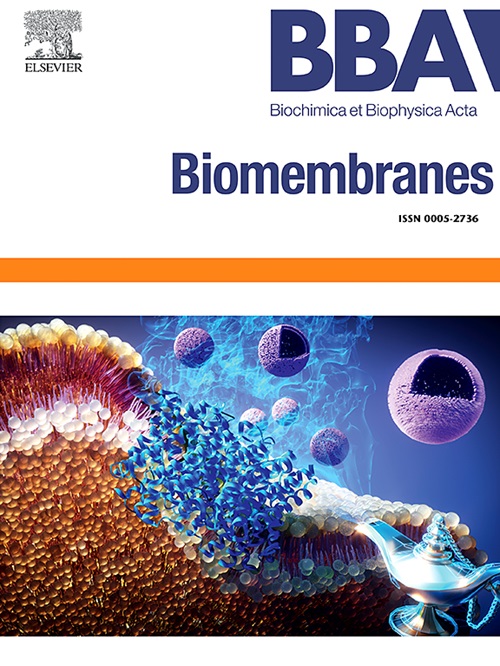膜张力对(-)-表没食子儿茶素没食子酸盐诱导的单层大囊泡破裂的影响。
IF 2.5
3区 生物学
Q3 BIOCHEMISTRY & MOLECULAR BIOLOGY
引用次数: 0
摘要
(-)-表没食子儿茶素没食子酸酯(EGCg),茶儿茶素,具有抗菌活性。EGCg诱导巨大单层囊泡(GUVs)破裂,导致其内部内容物泄漏。在这里,我们检测了膜张力对卵磷脂诱导的二油基磷脂酰胆碱(DOPC)- guv爆发的影响。在无膜张力的情况下,egcg诱导的GUV破裂观察表明,在~10 ms内,膜上先形成微孔,微孔半径随时间迅速增大,但GUV直径没有变化,随后GUV直径减小为脂质膜聚集体。接下来,我们研究了膜张力对egcg诱导的guv分数面积变化(δ)及其破裂的影响。在EGCg与低张力(≤0.5 mN/m)的GUV相互作用过程中,δ先小幅升高,后降至负值,GUV膜和管腔内出现致密颗粒、窄管等内翻结构,形成孔洞,导致GUV破裂。在较高的张力下,δ随时间增加而增加。当膜张力达到3.0 mN/m时,作用5 min后破裂GUV的比例Pburst(5 min)随着膜张力的增加而降低,表明膜张力抑制了破裂。在相互作用的5 min内,Pburst(5 min)随着出现内陷结构的guv比例的增加而增加,表明内陷结构的形成可能是egcg诱导的初始孔隙形成的原因。我们提出了一种张力作用于卵磷脂诱导的孔隙形成的机制。本文章由计算机程序翻译,如有差异,请以英文原文为准。

Effect of membrane tension on (−)-epigallocatechin gallate-induced burst of single giant unilamellar vesicles
(−)-Epigallocatechin gallate (EGCg), a tea catechin, exhibits antimicrobial activity. EGCg induces burst of giant unilamellar vesicles (GUVs), resulting in leakage of their internal contents. Here, we examined the effect of membrane tension on the EGCg-induced burst of dioleoylphosphatidylcholine (DOPC)-GUVs. The observation of the EGCg-induced burst of GUVs without membrane tension indicated that first a micropore was formed in the membrane and then its radius rapidly increased with time within ~10 ms without a change in the GUV diameter, and then the GUV diameter decreased to a lipid membrane aggregate. Next, we examined the effect of membrane tension on the EGCg-induced fractional area change (δ) of GUVs and its burst. During the interaction of EGCg with a GUV with low tension (≤ 0.5 mN/m), the δ initially increased slightly and then decreased to negative values, concomitant with the appearance of invaginated structures such as dense particles and narrow tubes in the GUV membrane and lumen, resulting in pore formation and subsequent GUV burst. By contrast, at higher tension, δ increased with time. The fraction of burst GUV after 5 min of interaction, Pburst (5 min), decreased with increasing tension up to 3.0 mN/m, indicating that membrane tension suppressed the burst. The Pburst (5 min) increased with increasing the fraction of GUVs in which invaginated structures appeared within 5 min of interaction, suggesting that the formation of invaginated structures may cause the initial EGCg-induced pore formation. We have proposed a mechanism of the tension effect on the EGCg-induced pore formation.
求助全文
通过发布文献求助,成功后即可免费获取论文全文。
去求助
来源期刊

Biochimica et biophysica acta. Biomembranes
生物-生化与分子生物学
CiteScore
8.20
自引率
5.90%
发文量
175
审稿时长
2.3 months
期刊介绍:
BBA Biomembranes has its main focus on membrane structure, function and biomolecular organization, membrane proteins, receptors, channels and anchors, fluidity and composition, model membranes and liposomes, membrane surface studies and ligand interactions, transport studies, and membrane dynamics.
 求助内容:
求助内容: 应助结果提醒方式:
应助结果提醒方式:


